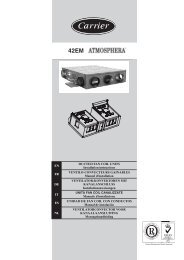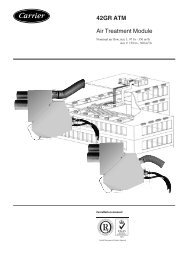19XR (PIC II) Hermetic Centrifugal Liquid Chillers 50 Hz - Carrier
19XR (PIC II) Hermetic Centrifugal Liquid Chillers 50 Hz - Carrier
19XR (PIC II) Hermetic Centrifugal Liquid Chillers 50 Hz - Carrier
Create successful ePaper yourself
Turn your PDF publications into a flip-book with our unique Google optimized e-Paper software.
A 1800-Watt oil heater is controlled by the <strong>PIC</strong> <strong>II</strong> to maintain<br />
oil temperature (see the Controls section) when the compressor<br />
is off. The Status02 screen of the local interface displays whether<br />
the heater is energized or not. If the <strong>PIC</strong> <strong>II</strong> shows that the heater<br />
is energized, but the sump is not heating up, the power to the oil<br />
heater may be off or the oil level may be too low. Check the oil<br />
level, the oil heater contactor voltage, and oil heater resistance.<br />
The <strong>PIC</strong> <strong>II</strong> will not permit compressor start-up if the oil temperature<br />
is too low. The control will continue with start-up only<br />
after the temperature is within limits.<br />
7.3 - Scheduled maintenance<br />
Any work must be done by authorised personnel. Establish a<br />
regular maintenance schedule based on the actual chiller<br />
requirements such as chiller load, run hours, and water quality.<br />
The time intervals listed in this section are offered as guides to<br />
service only.<br />
7.3.1 - Service Ontime<br />
The CVC will display a SERVICE ONTIME value on the<br />
'MAINSTAT' status screen. This value should be reset to zero<br />
by the service person or the operator each time major service<br />
work is completed so that time between service can be viewed.<br />
7.3.2 - Inspect the Control Centre<br />
Maintenance is limited to general cleaning and tightening of<br />
connections. Vacuum the cabinet to eliminate dust build-up. If<br />
the chiller control malfunctions, refer to the Troubleshooting<br />
Guide section for control checks and adjustments.<br />
CAUTION: Be sure power to the control centre is off when<br />
cleaning and tightening connections inside the control centre.<br />
Check Safety and Operating Controls Monthly<br />
To ensure chiller protection, the Control Test Automated Test<br />
should be done at least once per month. See Table 3 (Controls<br />
IOM) for safety control settings (see chapter 'Verification of<br />
the pressure switch calibration').<br />
7.3.3 - Changing Oil Filter<br />
Change the oil filter on a yearly basis or when the chiller is<br />
opened for repairs. The <strong>19XR</strong> has an isolatable oil filter so that<br />
the filter may be changed with the refrigerant remaining in the<br />
chiller. Use the following procedure:<br />
1. Make sure that the compressor is off and the disconnect<br />
for the compressor is open.<br />
2. Disconnect the power to the oil pump.<br />
3. Close the oil filter isolation valves (Fig. 4).<br />
4. Connect an oil charging hose from the oil charging valve<br />
(Fig. 4) and place the other end in a clean container suitable<br />
for used oil. The oil drained from the filter housing should<br />
be used as an oil sample and sent to a laboratory for proper<br />
analysis. Do not contaminate this sample.<br />
5. Slowly open the charging valve to drain the oil from the<br />
housing.<br />
52<br />
CAUTION: The oil filter housing is at a high pressure.<br />
Relieve this pressure slowly.<br />
6. Once all oil has been drained, place some rags or absorbent<br />
material under the oil filter housing to catch any drips<br />
once the filter is opened. Remove the 4 bolts from the end<br />
of the filter housing and remove the filter cover.<br />
7. Remove the filter retainer by unscrewing the retainer nut.<br />
The filter may now be removed and disposed of properly.<br />
8. Replace the old filter with a new filter. Install the filter<br />
retainer and tighten down the retainer nut. Install the filter<br />
cover and tighten the 4 bolts.<br />
9. Evacuate the filter housing by placing a vacuum pump on<br />
the charging valve. Follow the normal evacuation procedures.<br />
Shut the charging valve when done and reconnect the<br />
valve so that new oil can be pumped into the filter housing.<br />
Fill with the same amount that was removed, then close<br />
the charging valve.<br />
10. Remove the hose from the charging valve, open the isolation<br />
valves to the filter housing, and turn on the power to<br />
the pump and the motor.<br />
7.3.4 - Oil Specification<br />
If oil is added, it must meet the following <strong>Carrier</strong> specifications:<br />
Oil Type for units using R-134a<br />
Inhibited polyolester-based synthetic compressor oil formatted<br />
for use with HFC, gear-driven, hermetic compressors<br />
ISO Viscosity Grade 68<br />
The polyolester-based oil (P/N: PP23BZ103) may be ordered<br />
from your local <strong>Carrier</strong> representative.<br />
Oil Changes<br />
<strong>Carrier</strong> recommends changing the oil after the first year of operation<br />
and every three years thereafter in addition to an oil analysis.<br />
However, if a continuous oil monitoring system is used and a<br />
yearly oil analysis is performed (Periodic Oil Diagnosis), time<br />
between oil changes can be extended.<br />
To change the oil<br />
1. Transfer the refrigerant into the chiller condenser (for isolatable<br />
vessels) or a pumpout storage tank.<br />
2. Mark the existing oil level.<br />
3. Open the control and oil heater circuit breaker.<br />
4. When the chiller pressure is 34 kPa or less, drain the oil<br />
reservoir by opening the oil charging valve (Fig. 2). Slowly<br />
open the valve against refrigerant pressure (see chapter<br />
'Safety Considerations').<br />
5. Change the oil filter at this time.<br />
6. Change the refrigerant filter at this time.<br />
7. Charge the chiller with oil. Charge until the oil level is<br />
equal to the oil level marked in Step 2. Turn on the power<br />
to the oil heater and let the <strong>PIC</strong> <strong>II</strong> warm it up to at least<br />
60°C. Operate the oil pump manually, through the Control<br />
Test, for 2 minutes. The oil level should be full in the lower<br />
sight glass for shutdown conditions. If the oil level is above<br />
1/2 full in the upper sight glass, remove the excess oil.<br />
The oil level should now be equal to the amount shown in<br />
Step 2.




